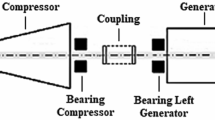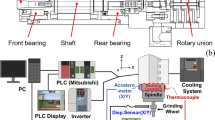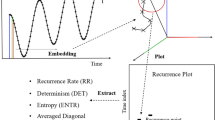Abstract
Recent advances in sensor technology and computing capabilities have enabled the creation of data-driven models that can support real-time decision making. Such a decision aid can allow for predictive maintenance (PdM) to be undertaken on a much greater scale in manufacturing plants. PdM includes data-driven prognostics and health management (PHM). A key element in developing prognostic models involves the acquisition of high-quality data, traditionally achieved through feature extraction methods to distill meaningful insights from extensive and noisy datasets. However, such methods may not handle noisy data well or address measurement errors adequately, potentially resulting in extracted features that inadequately represent the degradation process as a machine approaches failure or fault. Also, effects of sensor types on the feature extraction and prediction model have not been much explored yet. To overcome this limitation, we proposed a solution which involves dynamic feature extraction where a statistical penalty is introduced to mitigate the influence of noisy statistical features within a monotonic trend. Subsequently, the features extracted using this method are utilized to construct a health indicator (HI). Leveraging historical HI values, a probabilistic regression model may be used to forecast the time to failure (TTF) of rotating machinery with uncertainty propagation. To validate the proposed method, acceleration data were collected from rotating machinery for several run-to-failure cases. The proposed method is demonstrated to provide excellent forecasts of TTF for both accelerometer types.












Similar content being viewed by others
Notes
When a machine failure occurs, many in the literature describe this as the "end of useful life." But, of course, in many cases the machine can be repaired to put it back into service life. For such a case, the authors prefer the phrase "time to failure (TTF)" over the frequently used "remaining useful life (RUL)." For elements that cannot be repaired, such as a bearing, RUL is certainly appropriate.
In all, roughly 7000 h of data were collected on each of the three pumps using the two types of accelerometers. Every hour a sample was collected from each accelerometer (sampling rates of 12,000 Hz for piezo and 545 Hz for MEMS). These data were all stored and could be reviewed as necessary. In practice, the pumps were operated using a run-to-failure approach. When a failure occurred, the data leading up to the failure was analyzed. The data records in Fig. 5 do not show the entire "run-to-failure," but rather the portion of the signal in the days leading up to the failure, i.e., "function to failure."
References
Hu Q, Si XS, Zhang QH, Qin AS (2020) A rotating machinery fault diagnosis method based on multi-scale dimensionless indicators and random forests. Mech Syst Signal Process 139:106609
Moshrefzadeh A (2021) Condition monitoring and intelligent diagnosis of rolling element bearings under constant/variable load and speed conditions. Mech Syst Signal Process 149:107153. https://doi.org/10.1016/j.ymssp.2020.107153
Qin A, Zhang Q, Hu Q et al (2017) Remaining useful life prediction for rotating machinery based on optimal degradation indicator. Shock Vib 2017 Article ID 6754968, pp 12
Lee WJ, Wu H, Huang A, Sutherland JW (2020) Learning via acceleration spectrograms of a DC motor system with application to condition monitoring. Int J Adv Manuf Technol 106:803–816
Bektas O, Jones JA, Sankararaman S et al (2019) A neural network filtering approach for similarity-based remaining useful life estimation. Int J Adv Manuf Technol 101:87–103
Huang Z, Xu Z, Ke X et al (2017) Remaining useful life prediction for an adaptive skew-Wiener process model. Mech Syst Signal Process 87:294–306. https://doi.org/10.1016/j.ymssp.2016.10.027
Kim S, Kim NH, Choi JH (2020) Prediction of remaining useful life by data augmentation technique based on dynamic time warping. Mech Syst Signal Process 136:106486. https://doi.org/10.1016/j.ymssp.2019.106486
Lei Y, Yang B, Jiang X et al (2020) Applications of machine learning to machine fault diagnosis: A review and roadmap. Mech Syst Signal Process 138:106587. https://doi.org/10.1016/j.ymssp.2019.106587
Zhao R, Yan R, Chen Z et al (2019) Deep learning and its applications to machine health monitoring. Mech Syst Signal Process 115:213–237. https://doi.org/10.1016/j.ymssp.2018.05.050
Lee WJ, Mendis GP, Sutherland JW (2019) Development of an intelligent tool condition monitoring system to identify manufacturing tradeoffs and optimal machining conditions. Procedia Manuf 33:256–263
Kumar P, Khalid S, Kim HS (2023) Prognostics and health management of rotating machinery of industrial robot with deep learning applications—A review. Mathematics 11. https://doi.org/10.3390/math11133008
Biggio L, Kastanis I (2020) Prognostics and Health Management of Industrial Assets: Current Progress and Road Ahead. Front Artif Intell 3:1–24. https://doi.org/10.3389/frai.2020.578613
Kimotho JK, Sextro W (2014) An approach for feature extraction and selection from non-trending data for machinery prognosis. Proc Second Eur Conf Progn Heal Manag Soc 5:1–8
Ren L, Cui J, Sun Y, Cheng X (2017) Multi-bearing remaining useful life collaborative prediction: A deep learning approach. J Manuf Syst 43:248–256
Ben AJ, Chebel-Morello B, Saidi L et al (2015) Accurate bearing remaining useful life prediction based on Weibull distribution and artificial neural network. Mech Syst Signal Process 56:150–172
Park J, Hamadache M, Ha JM et al (2019) A positive energy residual (PER) based planetary gear fault detection method under variable speed conditions. Mech Syst Signal Process 117:347–360
Guo L, Li N, Jia F et al (2017) A recurrent neural network based health indicator for remaining useful life prediction of bearings. Neurocomputing 240:98–109
Li X, Duan F, Mba D, Bennett I (2017) Multidimensional prognostics for rotating machinery: A review. Adv Mech Eng 9:1–20
Yang F, Habibullah MS, Shen Y (2021) Remaining useful life prediction of induction motors using nonlinear degradation of health index. Mech Syst Signal Process 148:107183. https://doi.org/10.1016/j.ymssp.2020.107183
Li X, Yang Y, Bennett I, Mba D (2019) Condition monitoring of rotating machines under time-varying conditions based on adaptive canonical variate analysis. Mech Syst Signal Process 131:348–363. https://doi.org/10.1016/j.ymssp.2019.05.048
Hong S, Zhou Z (2012) Application of Gaussian Process Regression for bearing degradation assessment. In: 2012 6th International Conference on New Trends in Information Science, Service Science and Data Mining (ISSDM2012). IEEE, pp 644–648
(2017) Choosing the Right Type of Accelerometer. https://www.mouser.com/pdfdocs/choosing-the-right-accelerometer-white-paper.pdf. Accessed 15 Sep 2020
LSM. https://engineering.purdue.edu/LSM. Accessed 15 Sep 2020
Silverman BW (1986) Density Estimation for Statistics and Data Analysis. Chapman and Hall/CRC, New York
Coble J, Wesley Hines J (2009) Identifying optimal prognostic parameters from data: a genetic algorithms approach. In: Annual conference of the prognostics and health management society, vol 14, no 1
Lee WJ, Mendis GP, Triebe M, Sutherland J (2020) Monitoring of a machining process using kernel principal component analysis and kernel density estimation. J Intell Manuf 31:1175–1189
Chati YS, Balakrishnan H (2017) A Gaussian Process Regression approach to model aircraft engine fuel flow rate. In: 2017 ACM/IEEE 8th International Conference on Cyber-Physical Systems (ICCPS). IEEE, pp 131–140
Bishop CM (2006) Pattern Recognition and Machine Learning. Springer, New York
Holt CC (2004) Forecasting seasonals and trends by exponentially weighted moving averages. Int J Forecast 20:5–10. https://doi.org/10.1016/j.ijforecast.2003.09.015
Acknowledgements
This work is supported by part of a project funded through the Wabash Heartland Innovation Network (WHIN) and the SMART Film consortium at Purdue University.
Funding
This work is supported by part of a project funded through the Wabash Heartland Innovation Network (WHIN) and the SMART Film consortium at Purdue University.
Author information
Authors and Affiliations
Contributions
Wo Jae Lee contributed to the conceptualization, methodology, experiment, software, and evaluation. John W. Sutherland contributed to the methodology, and reviewed and edited the paper.
Corresponding author
Ethics declarations
Competing interests
The authors have no relevant financial or non-financial interests to disclose.
Additional information
Publisher's Note
Springer Nature remains neutral with regard to jurisdictional claims in published maps and institutional affiliations.
Rights and permissions
Springer Nature or its licensor (e.g. a society or other partner) holds exclusive rights to this article under a publishing agreement with the author(s) or other rightsholder(s); author self-archiving of the accepted manuscript version of this article is solely governed by the terms of such publishing agreement and applicable law.
About this article
Cite this article
Lee, W.J., Sutherland, J.W. Time to failure prediction of rotating machinery using dynamic feature extraction and gaussian process regression. Int J Adv Manuf Technol 130, 2939–2955 (2024). https://doi.org/10.1007/s00170-023-12799-8
Received:
Accepted:
Published:
Issue Date:
DOI: https://doi.org/10.1007/s00170-023-12799-8




